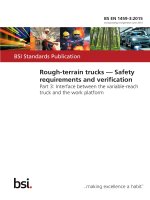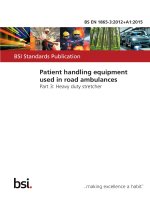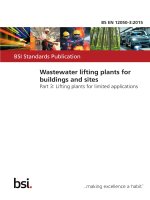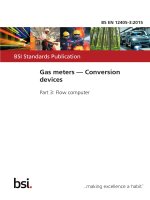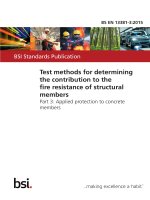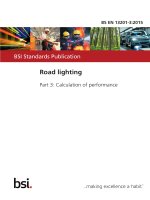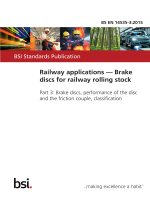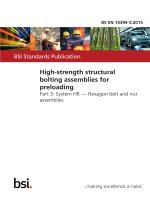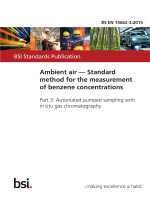Bsi bs en 62320 3 2015
Bạn đang xem bản rút gọn của tài liệu. Xem và tải ngay bản đầy đủ của tài liệu tại đây (1.77 MB, 108 trang )
BS EN 62320-3:2015
BSI Standards Publication
Maritime navigation and
radiocommunication
equipment and systems —
Automatic identification
system (AIS)
Part 3: Repeater stations — Minimum
operational and performance requirements —
Methods of test and required test results
BS EN 62320-3:2015 BRITISH STANDARD
National foreword
This British Standard is the UK implementation of EN 62320-3:2015. It is
identical to IEC 62320-3:2015.
The UK participation in its preparation was entrusted to Technical
Committee EPL/80, Maritime navigation and radiocommunication
equipment and systems.
A list of organizations represented on this committee can be obtained on
request to its secretary.
This publication does not purport to include all the necessary provisions of
a contract. Users are responsible for its correct application.
© The British Standards Institution 2015.
Published by BSI Standards Limited 2015
ISBN 978 0 580 81978 0
ICS 47.020.70
Compliance with a British Standard cannot confer immunity from
legal obligations.
This British Standard was published under the authority of the
Standards Policy and Strategy Committee on 30 April 2015.
Amendments/corrigenda issued since publication
Date Text affected
EUROPEAN STANDARD BS EN 62320-3:2015
NORME EUROPÉENNE
EUROPÄISCHE NORM EN 62320-3
ICS 47.020.70 March 2015
English Version
Maritime navigation and radiocommunication equipment and
systems - Automatic identification systems (AIS) -
Part 3: Repeater stations - Minimum operational and
performance requirements -
Methods of test and required test results
(IEC 62320-3:2015)
Matériels et systèmes de navigation et de Navigations- und Funkkommunikationsgeräte und -systeme
radiocommunication maritimes - Systèmes d'identification für die Seeschifffahrt - Automatisches Identifikationssystem
(AIS) - Teil 3: Repeater Stationen - Mindest-Betriebs- und -
automatique (AIS) - Partie 3: Stations de répéteurs -
Exigences de fonctionnement et de performance minimales Leistungsanforderungen - Prüfverfahren und geforderte
Prüfergebnisse
- Méthodes d'essai et résultats d'essai exigés
(IEC 62320-3:2015) (IEC 62320-3:2015)
This European Standard was approved by CENELEC on 2015-03-04. CENELEC members are bound to comply with the CEN/CENELEC
Internal Regulations which stipulate the conditions for giving this European Standard the status of a national standard without any alteration.
Up-to-date lists and bibliographical references concerning such national standards may be obtained on application to the CEN-CENELEC
Management Centre or to any CENELEC member.
This European Standard exists in three official versions (English, French, German). A version in any other language made by translation
under the responsibility of a CENELEC member into its own language and notified to the CEN-CENELEC Management Centre has the
same status as the official versions.
CENELEC members are the national electrotechnical committees of Austria, Belgium, Bulgaria, Croatia, Cyprus, the Czech Republic,
Denmark, Estonia, Finland, Former Yugoslav Republic of Macedonia, France, Germany, Greece, Hungary, Iceland, Ireland, Italy, Latvia,
Lithuania, Luxembourg, Malta, the Netherlands, Norway, Poland, Portugal, Romania, Slovakia, Slovenia, Spain, Sweden, Switzerland,
Turkey and the United Kingdom.
European Committee for Electrotechnical Standardization
Comité Européen de Normalisation Electrotechnique
Europäisches Komitee für Elektrotechnische Normung
CEN-CENELEC Management Centre: Avenue Marnix 17, B-1000 Brussels
© 2015 CENELEC All rights of exploitation in any form and by any means reserved worldwide for CENELEC Members.
Ref. No. EN 62320-3:2015 E
BS EN 62320-3:2015
EN 62320-3:2015 - 2 -
Foreword
The text of document 80/744/FDIS, future edition 1 of IEC 62320-3, prepared by IEC/TC 80 "Maritime
navigation and radiocommunication equipment and systems" was submitted to the IEC-CENELEC
parallel vote and approved by CENELEC as EN 62320-3:2015.
The following dates are fixed:
• latest date by which the document has to be implemented at (dop) 2015-12-04
national level by publication of an identical national
standard or by endorsement
• latest date by which the national standards conflicting with (dow) 2018-03-04
the document have to be withdrawn
Attention is drawn to the possibility that some of the elements of this document may be the subject of
patent rights. CENELEC [and/or CEN] shall not be held responsible for identifying any or all such
patent rights.
Endorsement notice
The text of the International Standard IEC 62320-3:2015 was approved by CENELEC as a European
Standard without any modification.
IEC 61162-2 NOTE Harmonized as EN 61162-2.
IEC 61162-450 NOTE Harmonized as EN 61162-450.
BS EN 62320-3:2015
- 3 - EN 62320-3:2015
Annex ZA
(normative)
Normative references to international publications
with their corresponding European publications
The following documents, in whole or in part, are normatively referenced in this document and are
indispensable for its application. For dated references, only the edition cited applies. For undated
references, the latest edition of the referenced document (including any amendments) applies.
NOTE 1 When an International Publication has been modified by common modifications, indicated by (mod), the relevant
EN/HD applies.
NOTE 2 Up-to-date information on the latest versions of the European Standards listed in this annex is available here:
www.cenelec.eu.
Publication Year Title EN/HD Year
IEC 60945 - -
Maritime navigation andEN 60945
-
radiocommunication equipment and
-
systems - General requirements - Methods -
-
of testing and required test results
-
IEC 61162-1 - Maritime navigation andEN 61162-1 -
radiocommunication equipment and
systems - Digital interfaces -- Part 1: Single
talker and multiple listeners
ITU Radio- Table of transmitting frequencies in the-
Regulations, VHF maritime mobile band
Appendix 18
ITU-R - Interim solutions for improved efficiency in-
the use of the band 156-174 MHz by
Recommendation stations in the maritime mobile service
Technical characteristics for a universal-
M.1084 shipborne automatic identification system
using time division multiple access in the
ITU-R - VHF maritime mobile band
Assignment and use of identities in the-
Recommendation maritime mobile service
M.1371
ITU-R -
Recommendation
M.585
ITU-R - O.153 : Basic parameters for the-
measurement of error performance at bit
Recommendation rates below the primary rate
O.153
– 2 – BS EN 62320-3:2015
IEC 62320-3:2015 IEC 2015
CONTENTS
INTRODUCTION ..................................................................................................................... 8
1 Scope ..............................................................................................................................9
2 Normative references ......................................................................................................9
3 Symbols and abbreviations ............................................................................................ 10
4 Functional requirements for a repeater station ...............................................................11
4.1 General................................................................................................................. 11
4.1.1 Types of repeater stations ............................................................................. 11
4.1.2 Repeating operation ...................................................................................... 11
4.1.3 Synchronisation ............................................................................................. 12
4.1.4 Access to the VDL ......................................................................................... 12
4.1.5 Configuration ................................................................................................. 13
4.2 Functional block diagram of an AIS repeater station .............................................13
4.3 Repeating rules..................................................................................................... 14
4.3.1 General repeating rules ................................................................................. 14
4.3.2 Repeater station use of repeat indicator ........................................................15
4.3.3 Duplicate message filtering............................................................................15
4.3.4 Content filtering ............................................................................................. 16
4.3.5 Reporting interval filtering..............................................................................19
4.3.6 Channel filtering ............................................................................................ 19
4.3.7 Filtering procedure ........................................................................................ 19
4.3.8 Message processing ...................................................................................... 21
4.3.9 Overload protection ....................................................................................... 21
4.3.10 Slot selection using RSSI – RSSI measurement ............................................22
4.4 Message scheduling ............................................................................................. 22
4.4.1 Station report.................................................................................................22
4.4.2 Repeater station identification message structure ..........................................23
4.4.3 Broadcast active AIS-SART message ............................................................24
4.4.4 Configuration parameters ..............................................................................24
4.5 Repeater station input/output sentence formatters ................................................29
5 Performance requirements............................................................................................. 30
5.1 Cyclic redundancy check....................................................................................... 30
5.2 Physical layer requirement .................................................................................... 30
5.2.1 Transmitter requirements ...............................................................................30
5.2.2 Receiver requirements...................................................................................34
5.2.3 Power consumption .......................................................................................34
5.2.4 Environmental requirements ..........................................................................35
5.3 Link layer requirements......................................................................................... 35
6 Functional tests ............................................................................................................. 35
6.1 Configuration tests ................................................................................................ 35
6.1.1 Factory default settings .................................................................................35
6.1.2 Standard test set-up ...................................................................................... 36
6.1.3 Configuration via VDL .................................................................................... 37
6.2 Basic functional tests ............................................................................................ 38
6.2.1 Basic repetition test ....................................................................................... 38
6.2.2 Power setting.................................................................................................38
BS EN 62320-3:2015 – 3 –
IEC 62320-3:2015 IEC 2015
6.2.3 Repeat indicator handling .............................................................................. 39
6.2.4 Synchronisation jitter ..................................................................................... 40
6.3 VDL access........................................................................................................... 41
6.3.1 RATDMA ....................................................................................................... 41
6.3.2 FATDMA access ............................................................................................ 44
6.3.3 ITDMA access ............................................................................................... 44
6.4 Repetition rates .................................................................................................... 45
6.4.1 Downsampling ............................................................................................... 45
6.4.2 Fixed repetition interval ................................................................................. 46
6.4.3 Maximum VDL load........................................................................................46
6.4.4 Maximum transmissions per second ..............................................................47
6.4.5 Age of time stamp..........................................................................................47
6.5 Filtering ................................................................................................................ 48
6.5.1 Duplicate filtering...........................................................................................48
6.5.2 Channel filtering ............................................................................................ 48
6.5.3 Position filtering.............................................................................................49
6.5.4 Message type filtering.................................................................................... 51
6.5.5 Message content filtering ...............................................................................51
6.5.6 AIS-SART filtering ......................................................................................... 56
6.6 Repeater station identification message ................................................................56
6.6.1 Purpose ......................................................................................................... 56
6.6.2 Method of measurement ................................................................................56
6.6.3 Required results ............................................................................................ 57
7 Test conditions .............................................................................................................. 57
7.1 Normal and extreme test conditions ......................................................................57
7.1.1 Normal test conditions ...................................................................................57
7.1.2 Extreme test conditions .................................................................................57
7.2 Additional test arrangements.................................................................................57
7.2.1 Arrangements for test signals applied to the receiver input ............................57
7.2.2 Encoder for receiver measurements ..............................................................58
7.2.3 Waiver for receivers.......................................................................................58
7.2.4 Impedance ..................................................................................................... 58
7.2.5 Artificial antenna (dummy load) .....................................................................58
7.2.6 Facilities for access ....................................................................................... 58
7.2.7 Modes of operation of the transmitter.............................................................58
7.3 Measurement uncertainties ...................................................................................58
7.4 Test signals .......................................................................................................... 59
7.4.1 Standard test signal number 1 .......................................................................59
7.4.2 Standard test signal number 2 .......................................................................59
7.4.3 Standard test signal number 3 .......................................................................59
7.4.4 Standard test signal number 4 .......................................................................59
8 Physical radio tests ....................................................................................................... 60
8.1 Transceiver protection test....................................................................................60
8.1.1 Purpose ......................................................................................................... 60
8.1.2 Method of measurement ................................................................................60
8.1.3 Required results ............................................................................................ 61
8.2 TDMA transmitter .................................................................................................. 61
8.2.1 General ......................................................................................................... 61
8.2.2 Frequency error .............................................................................................61
– 4 – BS EN 62320-3:2015
IEC 62320-3:2015 IEC 2015
8.2.3 Carrier power.................................................................................................61
8.2.4 Modulation spectrum slotted transmission......................................................62
8.2.5 Transmitter test sequence and modulation accuracy verification ....................63
8.2.6 Transmitter output power versus time function ...............................................64
8.2.7 Intermodulation attenuation (Type 1 only) ...................................................... 66
8.3 TDMA receivers .................................................................................................... 67
8.3.1 Sensitivity ...................................................................................................... 67
8.3.2 Error behaviour at high input levels................................................................68
8.3.3 Co-channel rejection......................................................................................68
8.3.4 Adjacent channel selectivity...........................................................................69
8.3.5 Spurious response rejection .......................................................................... 70
8.3.6 Intermodulation response rejection ................................................................72
8.3.7 Blocking or desensitisation ............................................................................ 73
8.3.8 Conducted spurious emissions at the antenna ...............................................74
Annex A (normative) Configuration structures ......................................................................75
A.1 General................................................................................................................. 75
A.2 PI sentences for repeater stations.........................................................................77
A.2.1 RFS – Repeater station FATDMA slots ..........................................................77
A.2.2 RMF – Repeater station MMSI filter ...............................................................79
A.2.3 Area configuration ......................................................................................... 79
A.3 Configuration via VDL using Message 26 ..............................................................83
Annex B (informative) Test area arrangement .................................................................... 103
Bibliography........................................................................................................................ 104
Figure 1 – Functional block diagram of an AIS repeater station.............................................14
Figure 2 – Power versus time characteristics ........................................................................32
Figure 3 – Format for repeating four-packet cluster...............................................................60
Figure 4 – Measurement arrangement ..................................................................................61
Figure 5 – Measurement arrangement ..................................................................................62
Figure 6 – Modulation spectrum for slotted transmission .......................................................63
Figure 7 – Measurement arrangement ..................................................................................63
Figure 8 – Power versus time characteristics ........................................................................65
Figure 9 – Measurement arrangement ..................................................................................66
Figure 10 – Measurement arrangement.................................................................................67
Figure 11 – Measurement arrangement.................................................................................68
Figure 12 – Measurement arrangement.................................................................................68
Figure 13 – Measurement arrangement.................................................................................69
Figure 14 – SINAD or PER/BER measuring equipment .........................................................71
Figure 15 – Measurement arrangement.................................................................................72
Figure 16 – Measurement arrangement.................................................................................73
Figure B.1 – Test area arrangement.................................................................................... 103
Table 1 – SOTDMA communication state of received station ................................................12
Table 2 – ITDMA Communication state of received station....................................................13
Table 3 – ITDMA communication state of received station with rescheduling ........................13
Table 4 – Duplicate message filtering parameters .................................................................16
Table 5 – Repeater station behaviour for message repeat.....................................................17
BS EN 62320-3:2015 – 5 –
IEC 62320-3:2015 IEC 2015
Table 6 – Contents of Message 26 used for repeater station identification ............................23
Table 7 – Alarm status definition for Table 6 ......................................................................... 24
Table 8 – Message 8 structure with AIS-SART related content..............................................24
Table 9 – Configurable parameters .......................................................................................25
Table 10 – Repetition parameters ......................................................................................... 26
Table 11 – Area related configuration parameters .................................................................28
Table 12 – Repeater station input/output sentence formatters ...............................................30
Table 13 – Transmitter parameters ....................................................................................... 31
Table 14 – Power versus time characteristics for Figure 2 ....................................................32
Table 15 – Required parameter settings for a repeater station ..............................................33
Table 16 – Required settings of physical layer constants ...................................................... 33
Table 17 – Modulation parameters of the physical layer of the repeater station .....................33
Table 18 – Required receiver characteristics ........................................................................ 34
Table 19 – Factory default values .........................................................................................35
Table 20 – Standard test set-up ............................................................................................ 36
Table 21 – Test area of standard test set-up ......................................................................... 37
Table 22 – Content of first two packets ................................................................................. 60
Table 23 – Fixed PRS data derived from Recommendation ITU-T O.153...............................60
Table 24 – Power versus time characteristics .......................................................................65
Table 25 – Frequencies for intermodulation tests ..................................................................73
Table A.1 – Basic system parameters ................................................................................... 76
Table A.2 – General repetition parameters............................................................................77
Table A.3 – Basic structure of Message 26 ........................................................................... 84
Table A.4 – Message 26 repeater command IDs ...................................................................84
Table A.5 – EPV configuration .............................................................................................. 85
Table A.6 – EPV query.......................................................................................................... 86
Table A.7 – Property identifiers for use with EPV – Basic system parameters .......................87
Table A.8 – Property identifiers for use with EPV – General repetition parameters................88
Table A.9 – AES key configuration ........................................................................................ 89
Table A.10 – RFS configuration ............................................................................................ 90
Table A.11 – RFS query........................................................................................................ 91
Table A.12 – RMF configuration............................................................................................92
Table A.13 – RMF query ....................................................................................................... 93
Table A.14 – RA1 configuration ............................................................................................ 94
Table A.15 – RA1 query........................................................................................................ 95
Table A.16 – RA2 configuration ............................................................................................ 96
Table A.17 – RA2 query........................................................................................................ 98
Table A.18 – RA3 configuration ............................................................................................ 99
Table A.19 – RA3 query...................................................................................................... 100
Table A.20 – RA4 configuration .......................................................................................... 101
Table A.21 – RA4 query...................................................................................................... 102
– 8 – BS EN 62320-3:2015
IEC 62320-3:2015 IEC 2015
INTRODUCTION
Chapter V of the 1974 SOLAS Convention requires mandatory carriage of Automatic
Identification System (AIS) equipment on all vessels constructed on or after 01 July 2002.
Implementation for other types and sizes of SOLAS Convention vessels was required to be
completed not later than 31 December 2004.
SOLAS Chapter V, Regulation 19, section 2.4.5 states that AIS shall:
a) provide automatically to appropriate equipped shore stations, other ships and aircraft
information, including ship's identity, type, position, course, speed, navigational status and
other safety-related information;
b) receive automatically such information from similarly fitted ships;
c) monitor and track ships; and
d) exchange data with shore-based facilities.
In addition, the IMO Performance Standards for AIS states that:
• The AIS should improve the safety of navigation by assisting in the efficient navigation of
ships, protection of the environment, and operation of Vessel Traffic Services (VTS), by
satisfying the following functional requirements:
1) in a ship-to-ship mode for collision avoidance;
2) as a means for littoral States to obtain information about a ship and its cargo; and
3) as a VTS tool, i. e. ship-to-shore (traffic management).
• The AIS should be capable of providing to ships and to competent authorities, information
from the ship, automatically and with the required accuracy and frequency, to facilitate
accurate tracking. Transmission of the data should be with the minimum involvement of
ship's personnel and with a high level of availability.
The provision of Shore Based AIS will be necessary to attain the full benefit of the SOLAS
Convention requirements.
This standard provides the minimum operational and performance requirements, methods of
test and the required test results for AIS repeater stations. The testing is divided into two
parts, the logical tests and the transceiver tests. These are captured in Clause 6 and Clause 8
respectively.
BS EN 62320-3:2015 – 9 –
IEC 62320-3:2015 IEC 2015
MARITIME NAVIGATION AND
RADIOCOMMUNICATION EQUIPMENT AND SYSTEMS –
AUTOMATIC IDENTIFICATION SYSTEM (AIS) –
Part 3: Repeater stations –
Minimum operational and performance requirements –
Methods of test and required test results
1 Scope
This part of IEC 62320 specifies the minimum operational and performance requirements,
methods of testing and required test results for AIS repeater stations, compatible with the
performance standards adopted by IMO Res. MSC.74 (69), annex 3, Universal AIS. It
incorporates the technical characteristics of non-shipborne, fixed station AIS equipment,
included in Recommendation ITU-R M.1371 and IALA Recommendation A-124. Where
applicable, it also takes into account the ITU Radio Regulations. This standard takes into
account other associated IEC International Standards and existing national standards, as
applicable.
This standard is applicable for AIS repeater stations. It does not include specifications for the
display of AIS data on shore.
2 Normative references
The following documents, in whole or in part, are normatively referenced in this document and
are indispensable for its application. For dated references, only the edition cited applies. For
undated references, the latest edition of the referenced document (including any
amendments) applies.
IEC 60945, Maritime navigation and radiocommunication equipment and systems – General
requirements – Methods of testing and required test results
IEC 61162-1, Maritime navigation and radiocommunication equipment and systems – Digital
interfaces – Part 1: Single talker and multiple listeners
ITU-R Recommendation M.585, Assignment and use of identities in the maritime mobile
service
ITU-R Recommendation M.1084, Interim solutions for improved efficiency in the use of the
band 156-174 MHz by stations in the maritime mobile service
ITU-R Recommendation M.1371, Technical characteristics for a universal shipborne
automatic identification system using time division multiple access in the VHF maritime mobile
band
ITU-T Recommendation O.153, Basic parameters for the measurement of error performance
at bit rates below the primary rate
ITU Radio Regulations, Appendix 18
– 10 – BS EN 62320-3:2015
IEC 62320-3:2015 IEC 2015
3 Symbols and abbreviations
AES Advanced Encryption Standard
AIS Automatic Identification System
AtoN Aids To Navigation
BER Bit Error Rate
BFO Beat frequency oscillator
BIIT Built-In Integrity Tests
BT Bandwidth Time product
COG Course Over Ground
CS Carrier Sense
CSTDMA Carrier Sense Time Division Multiple Access
DAC Digital Area Code
dBc Decibel-carrier
dBm Decibel-milliwatts
EUT Equipment under test
FATDMA Fixed Access Time Division Multiple Access
FI Function Identifier
FIFO First in, first out
GNSS Global Navigation Satellite System
IALA International Association of Marine Aids to Navigation and Lighthouse
Authorities
ITDMA Incremental Time Division Multiple Access
IMO International Maritime Organization
ITU International Telecommunication Union
kn Knots
MMSI Maritime Mobile Service Identity
NavStatus Navigational Status
NM Nautical Mile
NRZI Non-Return to Zero Inverted
PER Packet Error Rate
Pc Carrier Power
PI Presentation Interface
PPS Pulse(s) Per Second
RATDMA Random Access Time Division Multiple Access
RSSI Received Signal Strength Indication
Rx Receive
AIS-SART Search And Rescue Transmitter
SO Self-Organizing
SOG Speed Over Ground
SOTDMA Self-Organizing Time Division Multiple Access
TDMA Time Division Multiple Access
Tx Transmit
UTC Coordinated Universal Time
BS EN 62320-3:2015 – 11 –
IEC 62320-3:2015 IEC 2015
VCO Voltage controlled oscillator
VDL VHF Data Link
VHF Very High Frequency
VSWR Voltage Standing Wave Ratio
VTS Vessel Traffic Services
4 Functional requirements for a repeater station
4.1 General
4.1.1 Types of repeater stations
AIS repeater stations are designed to retransmit VDL messages in one or several steps to
extend the receiving range in areas with impaired VHF coverage. Careful consideration needs
to be taken not to overload the VDL with repeated messages, considering the additional load
repeated messages generate. The AIS environment may also contain one or more repeaters.
A repeater station is a store and forward repeater process.
A repeater station is a non-controlling station on the VDL.
The repeater station can be one of two types.
Type 1:
• Radio requirements as per the AIS base station requirements
• A dedicated repeater station is a Type 1 device
Type 2:
• Radio requirements as per the AIS AtoN station requirements
• Restricted repeater capability
• Suitable for areas with low AIS activity only
These two types of repeater functions can be implemented in three different ways:
• As a dedicated repeater station (Type 1)
• As an internal process of an AIS Base Station (Type 1)
• As an internal process of an AIS AtoN device (Type 2)
4.1.2 Repeating operation
(See 6.2.1)
4.1.2.1 Modes of repeating operation
The repeater station is designed for independent operation in autonomous and assigned
mode. No polled mode is allowed.
4.1.2.2 Message by message repeating
Each received message that shall be repeated is internally allocated for transmission using
RATDMA, ITDMA, or FATDMA as supported and configured.
4.1.2.3 Message rescheduling
This mode is only applicable for scheduled position reports.
– 12 – BS EN 62320-3:2015
IEC 62320-3:2015 IEC 2015
Received messages shall be analysed and the repeater station shall reschedule
transmissions using an ITDMA schedule.
The repeater station may reschedule repeated messages using a reporting interval different
from the original interval, depending on configuration.
4.1.3 Synchronisation
(See 6.2.4)
The repeater station shall primarily use an internal source for UTC direct synchronisation.
The repeater station can synchronise on any AIS station that has direct UTC (otherwise
known as UTC indirect). The repeater station shall have UTC direct, or UTC indirect and only
transmit when sync state is 0 or 1.
4.1.4 Access to the VDL
4.1.4.1 Means of access
Access to the VDL can be by using pre-configured transmission slots. Pre-configured
transmission slots shall in this case be reserved by Message 20 from a base station.
If pre-configured slots are not available, RATDMA may be used for transmission.
A repeater station shall use as a minimum RATDMA, ITDMA and FATDMA to allocate and
pre-announce transmissions.
The repeater station needs to take into account all received Message 20s. It shall respect slot
reservations. If a base station reserves slots for the repeater station, the repeater station shall
be configured to use FATDMA.
CSTDMA is not suitable for repeater stations and not permitted because of:
• slot start delay;
• no protection from collision with Class B CS units;
• only one slot messages;
• intentional slot reuse is not allowed.
4.1.4.2 RATDMA and FATDMA access scheme
(See 6.3.1, 6.3.2)
The repeater station shall not change the data content of the message, but shall change the
SOTDMA communication state or ITDMA if relevant. The repeater station shall change the
SOTDMA communication state as indicated in Table 1.
Table 1 – SOTDMA communication state of received station
Received parameter Transmit parameters
Change to Synch State of repeater station
Synch state Set to zero
Slot time out Set to zero
Slot offset
The repeater station shall change the ITDMA communication state as indicated in Table 2.
BS EN 62320-3:2015 – 13 –
IEC 62320-3:2015 IEC 2015
Table 2 – ITDMA Communication state of received station
Received parameter Transmit parameters
Synch state Change to synch state of repeater
Slot increment Set to zero
Number of slots Set to zero
Keep flag Set to FALSE ( = 0)
4.1.4.3 ITDMA access scheme
(See 6.3.3)
The repeater station shall not change the data content of the message, but shall change the
SOTDMA communication state or ITDMA as relevant. The repeater station shall change the
SOTDMA or ITDMA communication state to an ITDMA communication state as described in
Table 2. When using ITDMA to reschedule refer to Table 3.
If ITDMA is used and the repeater station receives a Message 1 that shall be repeated, the
repeater station shall change the message ID from 1 to 3 to all ITDMA access scheme.
Table 3 – ITDMA communication state of received station with rescheduling
Received parameter Transmit parameters
Synch state Change to synch state of repeater station
Slot increment Offset set to next transmission slot
Number of slots As required for next repeated message
Keep flag Set to FALSE ( = 0)
ITDMA can be used to schedule transmissions that originate from different stations.
When using ITDMA reservations, the selection interval shall be 150 slots. Set the ITDMA
communication state at time of transmission to the next scheduled transmission.
4.1.5 Configuration
(See 6.1.3)
Initial configuration shall be possible using the presentation interface of the repeater station
as defined in Annex A.
The repeater station may use VDL Messages for configuration and status reports as defined
in Clause A.3.
4.2 Functional block diagram of an AIS repeater station
Figure 1 shows the principal components of the AIS repeater station.
– 14 – BS EN 62320-3:2015
IEC 62320-3:2015 IEC 2015
Dedicated AIS Repeater station
Presentation Interface
Antenna system
I/O
Controller
AIS TX
Internal Sync AIS RX
Source AIS RX
Power
BIIT
IEC
Figure 1 – Functional block diagram of an AIS repeater station
As a minimum, the following functional elements are required for the AIS repeater station:
• two multi-channel receiving processes;
• one multi-channel TDMA transmitter;
NOTE Since the minimum configuration of the repeater station has only one transmitter, the repeater station
cannot transmit on both AIS Channels (AIS A and AIS B) simultaneously.
• a controlling unit, which includes a unique identifier to the repeater station;
• an internal synchronisation source capable of providing UTC;
• a Built-In-Integrity-Test unit (BIIT), which shall provide alarms;
• a power supply;
• an interface with data format conforming to IEC 61162-1. The physical interface will be
determined by the manufacturer. The interface shall output VDO sentences for all
transmitted messages, and VDM sentences for all received messages. Additionally, the
repeater station shall be configurable using the PI. The repeater station shall be
configurable for repeater enable via the VDL, and may optionally be configurable for all
parameters via the VDL.
4.3 Repeating rules
4.3.1 General repeating rules
(See 6.2.1, 6.4.5)
The repeater station is a store-and-forward process and shall use the FIFO principle.
Retransmission of messages shall be performed as soon as possible, according to
configuration, after receiving the relevant messages which are required to be retransmitted.
The maximum delay of the retransmission shall be within 9 s of reception in order to ensure
one minute interval UTC time stamp in a position report that has undergone multiple
BS EN 62320-3:2015 – 15 –
IEC 62320-3:2015 IEC 2015
repetitions. If RATDMA is used to transmit a message, the received message can be held for
maximum 4 s and 10 slots.
With the exception of AIS-SART position reports, messages containing a time stamp older
than 30 s shall not be repeated.
The repeater station shall be capable of retransmission of a message within 10 slots of
reception of that received message.
Received position messages (Message 1, 2, 3 or 18) shall replace queued messages from the
same MMSI (within a reasonable time limit to already scheduled transmission of the same
MMSI. Updating a queued message shall not take longer than 2 slots.
Retransmission (repeat) shall be performed on the same channel in which the original
message was received by the repeater station.
4.3.2 Repeater station use of repeat indicator
(See 6.2.3)
4.3.2.1 Repeat indicator value
Each time a received message is processed by the repeater station, the repeat indicator value
shall, at least, be incremented by one (+1) before retransmitting the message.
If the received repeat indicator equals 3, the relevant message shall not be retransmitted.
4.3.2.2 Message repetition process
A message is repeated based on the repeat indicator if the repeat indicator is less than the
“Max repeated RI” configuration value.
The repeat indicator of retransmitted message can be updated using two different methods.
a) Increment repeat indicator by one (+1), to a maximum value of three.
b) Set repeat indicator to the value defined by the “RI increment setting” configuration
parameter.
4.3.2.3 Configuration of repetition process
There are three parameters to configure the repetition process:
• incoming repeat indicator value limit;
• set if above value is the maximum number of repeats or a value for exact match;
• increment rule. Set to either increase repeat indicator by one (+1), or replace repeat
indicator with 3.
All repeater stations within coverage of one another should be set to the same number of
repeats, in order to ensure that “Binary acknowledgement” Message 7 and “Safety related
acknowledgement” Message 13 are delivered to the originating station.
4.3.3 Duplicate message filtering
(See 6.5.1)
The same message shall be repeated only once within 30 s, by the same repeater station
using the filtering parameters of Table 4. To make sure this is the case, messages shall be
checked using repeat history 30 s back in time.
– 16 – BS EN 62320-3:2015
IEC 62320-3:2015 IEC 2015
Table 4 – Duplicate message filtering parameters
Message type Filter parameters
Position reports (1,2,3,18, 21) MMSI, Time stamp
Static data (5,19) MMSI
Static data (24A,24B) MMSI, Message part
Binary messages (6, 8, 25, 26) MMSI, Binary data
Safety related messages (12,14) MMSI, Data
Other messages No filtering required
4.3.4 Content filtering
4.3.4.1 Filter by message type
(See 6.5.4)
Received messages shall be filtered according to Table 5.
BS EN 62320-3:2015 – 17 –
IEC 62320-3:2015 IEC 2015
Table 5 – Repeater station behaviour for message repeat
Message Repeating Action Comment
type allowed
1 Yes Amend communication state.
2 Yes Amend communication state.
3 Yes Amend communication state.
4 No Message 4 transmissions are not
candidates for slot reuse and shall
therefore not be repeated.
See a.
5 Yes
6 Yes
7 Yes
8 Yes
9 No SAR units generally have great range
and therefore do not require
retransmission.
10 No See a.
11 No See a.
12 Yes
13 Yes
14 Yes
15 Yes Disallow repeat of Message 15 with slot
offset.
16 No See b.
17 No Time to alarm for unhealthy satellites
may not be fulfilled. DGPS messages
may also be long.
18 Yes Amend communication state (check for Message 18 from CS and SOTDMA may
CS). be handled differently.
19 Yes
20 No See b.
21 Yes
22 No See b.
23 No See b.
24 Yes
25 Yes
26 Yes Amend communication state.
27 No Not intended to be received by mobiles.
Different frequencies.
a UTC time will not be accurate after retransmission, hence the message is not repeated.
b This is a VDL control message.
Any message type can be switched off by configuration.
4.3.4.2 AIS-SART filtering rules
(See 6.5.6)
Received message filtering shall use the following rules:
– 18 – BS EN 62320-3:2015
IEC 62320-3:2015 IEC 2015
• repetition of AIS-SART test messages is configurable with “default=don’t repeat” this
includes the AIS-SART text messages while undergoing tests;
• active AIS-SART position reports without a position shall be repeated;
• capability to trigger binary and text messages on reception of an active AIS-SART
message shall contain repeater ID and RSSI of the received AIS-SART message;
• only one message from the burst can be repeated;
• continue repetition once per minute for 15 min after last message received. In this case
the timestamp in the repeated AIS-SART position report shall be set to 60 (unavailable);
• prioritise active AIS-SART messages over others under heavy VDL load;
• filtering shall be disabled for active AIS-SART.
NOTE The “SART” in this standard includes devices using AIS-SART technology such as AIS-SART, AIS-MOB
and EPIRB-AIS as defined in Recommendation ITU-R M.1371.
4.3.4.3 Filter by position
(See 6.5.3)
4.3.4.3.1 Defined areas
Messages shall be filtered by position using defined areas. When a message that does not
contain a position field is received from a station whose position is not yet known, no filtering
shall be applied. For example if a Message 5 is received before a position message from the
same station is received, the Message 5 shall not be filtered.
A position report received from a station with a “default=not available” position shall not be
repeated.
4.3.4.3.2 Area filter rules
(See 6.5.3)
Include/Exclude rule set – Each area defined shall be for either inclusion or exclusion of
retransmission. If no included area is defined, the repeater station shall not retransmit any
VDL message.
Number of areas – Minimum number of configurable areas shall be 8 in total. Overlapping
areas are allowed. Exclude from transmission areas have priority over include areas in case
of overlapping. An area for filtering is defined by two points forming a rectangle at its NE/SW
geographic coordinates.
Distance to areas – The distance to an area shall not be considered by the repeater station.
Area sizes – There shall be no minimum or maximum area size limit required.
4.3.4.4 Filter by other message content
(See 6.5.5)
It shall be possible to filter messages by specific parameters within the messages.
As a minimum it shall be possible to filter AIS units by:
SOG – A SOG threshold for exclusion when SOG is lower than the threshold value;
COG – A COG range shall be configurable for inclusion or exclusion;

